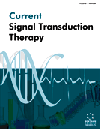- Home
- A-Z Publications
- Current Signal Transduction Therapy
- Previous Issues
- Volume 8, Issue 1, 2013
Current Signal Transduction Therapy - Volume 8, Issue 1, 2013
Volume 8, Issue 1, 2013
-
-
Overview of Molecular Signal Transduction of Malignant Gliomas and Correlation with Responses to Targeted Therapy Recent advances in Molecular Characterization of Glioblastoma
More LessAuthors: Ana C. deCarvalho, Norman L. Lehman and Tom MikkelsenMalignant gliomas are the most common primary central nervous system tumors, and the most aggressive and frequent form is the World Health Organization (WHO) grade IV astrocytoma, or glioblastoma. The standard treatment of glioblastoma consists of aggressive resection, radiation therapy, and concomitant and adjuvant treatment with the DNAalkylating agent temozolomide. Despite treatment, the prognosis is dism Read More
-
-
-
Application of Targeted Therapy to Malignant Gliomas and Response to Treatment
More LessAuthors: Eudocia Q. Lee, Andrew D. Norden, Jan Drappatz and Patrick Y. WenThe prognosis for malignant gliomas remains poor despite multimodality therapy. An increased understanding of the molecular pathogenesis involved in glioma development and growth has resulted in development of agents that specifically target these molecular processes and pathways. Except for inhibitors of the vascular endothelial growth factor pathway, results from most single agent trials have been mode Read More
-
-
-
Overview of Angiogenesis and the use of Bevacizumab in Patients with Malignant Gliomas
More LessBevacizumab is a humanised monoclonal antibody targeted to the vascular endothelial growth factor (VEGF). VEGF is the ligand for VEGF receptors (VEGFR), which are important for the development and maintenance of the angiogenic phenotype in high-grade solid tumors, including malignant gliomas. An overview of VEGF, VEGFR, and the pharmacology of bevacizumab will be presented. Bevacizumab is active in pre-clinical tes Read More
-
-
-
MicroRNA Functions and Potential Clinical Utility in Glioblastoma
More LessA flurry of recent research has established that microRNAs have fundamental roles in the biology of the aggressive brain tumor, glioblastoma multiforme. MicroRNAs function in multiple hallmark biological characteristics of glioblastoma, including cell proliferation, invasion, glioma stem cell behavior, and angiogenesis as well as sensitivity to conventional therapies. Many of these microRNAs intersect with key pathways in glio Read More
-
-
-
Overview of Brain Tumor Stem Cells – Implications for Treatment
More LessAuthors: Joseph L. Lasky III and Ichiro NakanoGlioblastoma multiforme (GBM) is the most commonly diagnosed primary Central Nervous System tumors in adults, with approximately 10,000 new cases annually in the United States. GBMs rank among the deadliest of all human cancers with no curative options available; no meaningful therapeutic advances have been made in over 30 years. Recurrence is inevitable in the vast majority of cases, and a permanent cure fo Read More
-
-
-
Therapeutic Targeting of Developmental Signaling Pathways in Medulloblastoma: Hedgehog, Notch, Wnt and Myc
More LessAuthors: Eric Raabe and Charles G. EberhartDuring development of the cerebellum, a large number of molecular factors interact to produce an intricate brain structure. Many of these developmentally significant genes are members of signaling cascades implicated in the formation and growth of the embryonal brain tumor medulloblastoma. Genes controlling critical developmental pathways such as Hedgehog, Notch, Wnt, and Myc are known to be overexpr Read More
-
-
-
Networking Between γc and GH-R Signaling in the Control of Cell Growth
More LessThe family of type I cytokines, including IL-2, IL-4, IL-7, IL-9, IL-15 and IL-21, shares common transducing element the common cytokine receptor γc. The receptors containing γc exert prominent mitogenic effects and play an important role in several immunological functions and in supporting cell survival. The γc-dependent cytokine receptors use the Janus Kinase (JAK)/Signal transducer and activator of transcription (STAT) sign Read More
-
-
-
Antiproliferative and Proapoptotic Effects of the TrK-inhibitor GW441756 in Human Myosarcomas and Prostatic Carcinoma
More LessNeurotrophins (NTs) and their receptors, TrKs and p75NTR, have been shown to regulate proliferation and apoptosis of neoplastic cells. Pharmacological TrK blockade is considered a valuable target in cancer therapy, and several TrK inhibitors are under investigation. However, only a few of them have reached the stage of clinical development. Myosarcomas are aggressive cancers, which secrete NGF and respond poo Read More
-
-
-
Molecular Mechanism of Anti-tumor Effect by Triptolide in Hematological Malignancies
More LessAuthors: Youping Wang and Yan ChenTriptolide is the major active ingredient of extracts derived from the traditional Chinese Medicine tripterygium wilfordii Hook F. As a complex natural extract, triptolide has a broad range of biological target points and exhibits a variety of pharmacological effects including anti-inflammatory, immunosuppressive, antioxidant, and anti-infertility. In addition, considerable evidences show that triptolide holds dramatic anti-tumor a Read More
-
-
-
MicroRNAs - Key Players in Haematopoiesis
More LessAuthors: Stephanie Gounaris-Shannon, Sarah Newbury and Timothy ChevassutSince the initial identification of microRNAs (miRNA) in C. elegans, functional characterisation of these small non-coding RNAs has demonstrated their critical involvement in numerous biological processes. Typically 20-22 nucleotides in length, miRNAs act as negative gene regulators at the post-transcriptional level. A large body of evidence points to the role of miRNAs in haematopoiesis. miRNAs provide a network of signals Read More
-
Volumes & issues
-
Volume 20 (2025)
-
Volume 19 (2024)
-
Volume 18 (2023)
-
Volume 17 (2022)
-
Volume 16 (2021)
-
Volume 15 (2020)
-
Volume 14 (2019)
-
Volume 13 (2018)
-
Volume 12 (2017)
-
Volume 11 (2016)
-
Volume 10 (2015)
-
Volume 9 (2014)
-
Volume 8 (2013)
-
Volume 7 (2012)
-
Volume 6 (2011)
-
Volume 5 (2010)
-
Volume 4 (2009)
-
Volume 3 (2008)
-
Volume 2 (2007)
-
Volume 1 (2006)
Most Read This Month
Article
content/journals/cst
Journal
10
5
false
en


